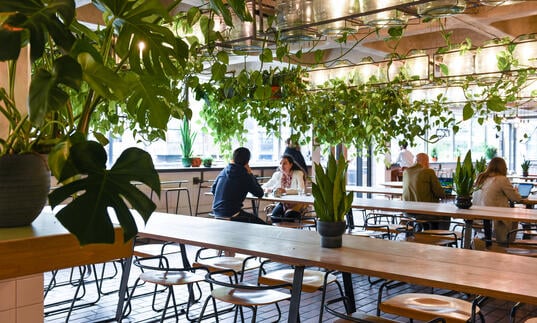
How do artists live? Here, four films explore liveability and livelihoods across four decades.
These films explore the multifarious means in which artists carve out a life for themselves in London, looking back to the 1950s all the way to the present day.
Artists Must Live is an early postwar record of the Arts Council mulling over the challenges of an artistic career in the 1950s; John Smith’s 1978 commission for Thames TV meets the residents of a new tower block in Hackney Marshes; the BBC Community Programme Unit profile the group of artists as they struggle to save their homes against rising property prices; and Emily Richardson returns to high-rise living after the millennium, encountering the everyday incidences of a tower block over several months in 2005.
Total Runtime: 103 minutes
This is a past event. Subscribe to our newsletters to hear about upcoming events
Booking fees
£1.50 booking fee per online/phone transaction.
No fee when tickets are booked in person.
Booking fees are per transaction and not per ticket. If your booking contains several events the highest booking fee will apply. The booking fee may be reduced on certain events. Members do not pay booking fees.
Programme
Artists Must Live
1953, John Read, Arts Council, 29 minutes
A survey of what it meant to live and work as an artist in 1950, covering a wide range of practitioners, the film provides a multitude of ways artists found to remain sustainable whilst developing their practice.
Hackney Marshes
1978, John Smith, Thames TV, 32 minutes
John Smith's ground breaking film challenges traditional TV documentary norms by focusing on Hackney's tower block residents and film-making conventions. Through interviews and unique compositions, including repetition and unexpected visuals like chalk lines and closing lift doors, the film disrupts viewer expectations, prompting a re-evaluation of their engagement.
Artists In Residence
BBC Community Programme Unit, 1988, 30 mins
'If you want a comfortable, secure life, being an artist has to be one of the worst ways of going about it’, so says artist Philip Stanley in this documentary focusing on the Beck Road collective, as the street which they rescued from dereliction is to be sold.
Block
Emily Richardson, 2005, 12 mins
Block is a round-the-clock portrait, shot over a duration of ten months, of a 1960s tower block in south east London.
Cinema 2
Location
Barbican Cinema 2 & 3 are located on Beech Street, a short walk from the Barbican’s Silk Street entrance. From Silk Street, you’ll see a zebra crossing that will take you across the road to the venue.
Address
Beech Street
London
EC2Y 8DS
Public transport
The Barbican is widely accessible by bus, tube, train and by foot or bicycle. Plan your journey and find more route information in ‘Your Visit’ or book your car parking space in advance.
We’ve plenty of places for you to relax and replenish, from coffee and cake to wood-fired pizzas and full pre-theatre menus
Access
Cinemas 2 & 3 are located at Beech Street, a short walk from the Barbican Centre’s main Silk Street entrance. There are a couple of steep, dropped kerbs and an incline to negotiate between the two sites. Level access from Beech Street.
Mobility
Each auditorium has three permanent wheelchair spaces (two in the third row and one in the front row) and 153 fixed seats with capacity for a further three spaces in the front row. Access to each auditorium is up a ramp. There are also a number of seats with step-free access.
Assistance dogs
Assistance dogs may be taken into the cinema – please tell us when booking to ensure your seat has enough space. If you prefer, you may leave your dog with a member of the foyer staff during the performance.
Hearing facility
An infrared system for hard of hearing customers is provided in each auditorium; headsets or neck loops can be collected from foyer staff. The ticket desk counter is fitted with an induction loop.
For more access information, please visit our Accessibility section.





